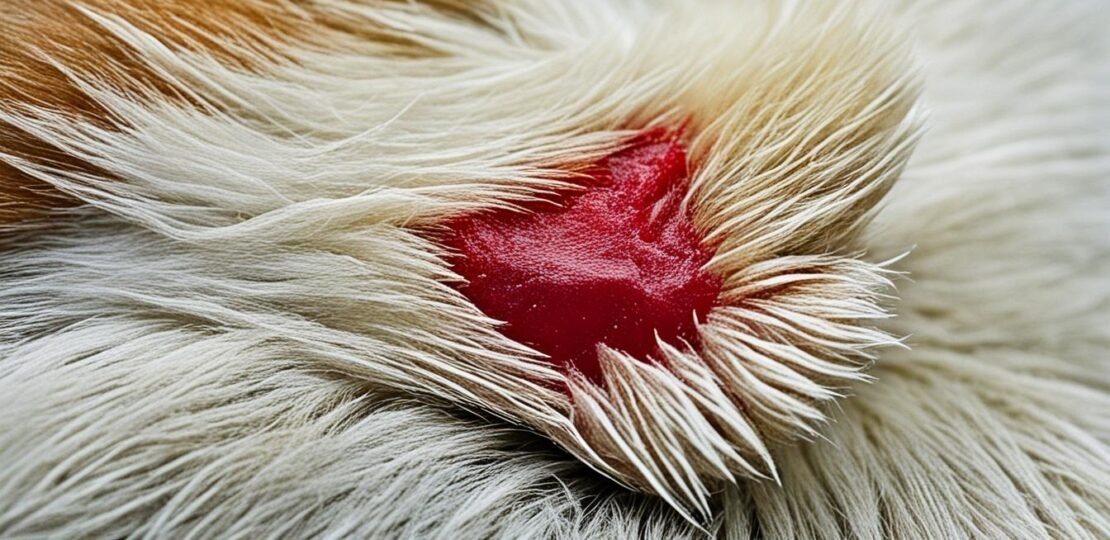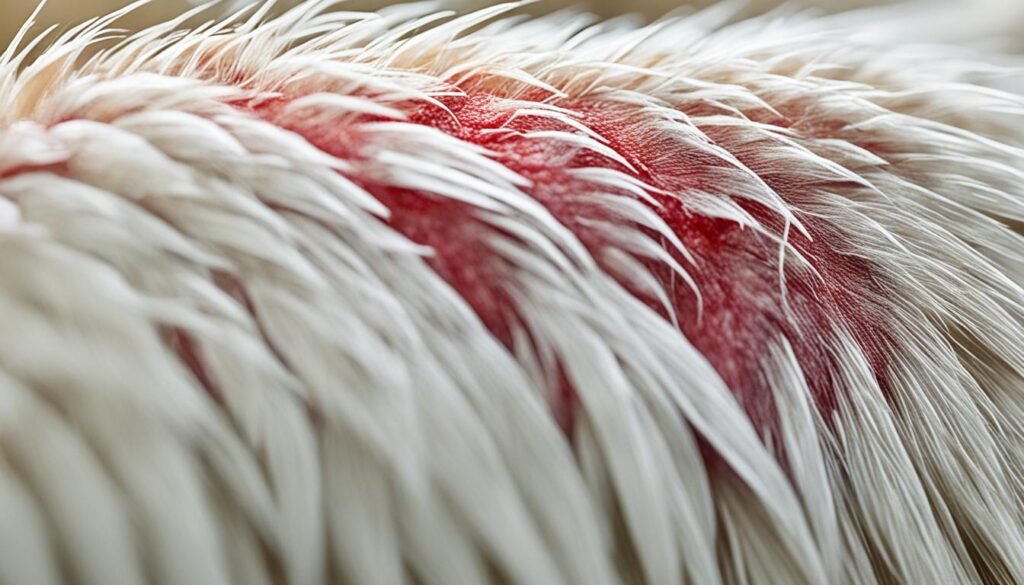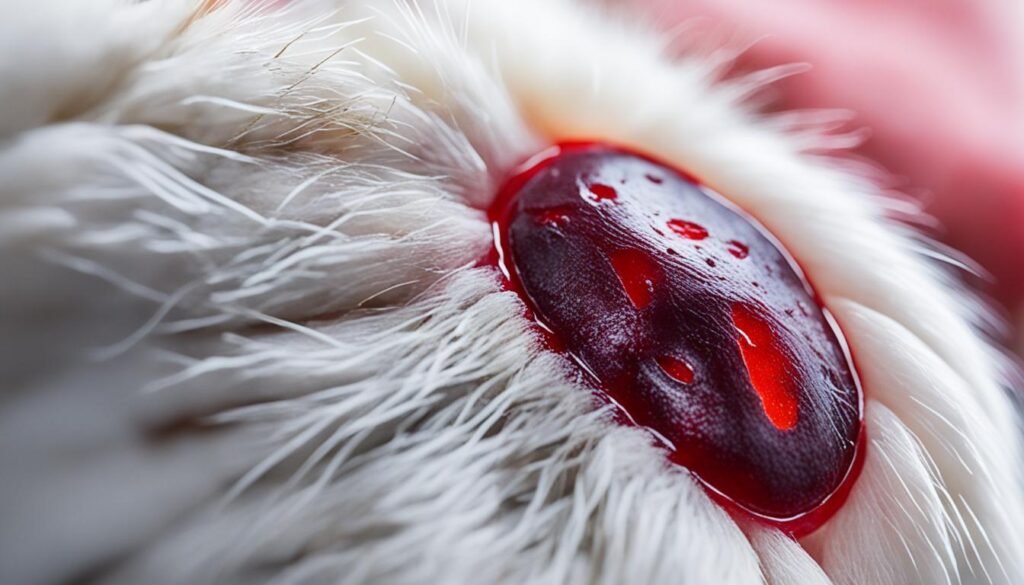
Welcome to our comprehensive guide on pet skin conditions! As pet owners, it’s essential to understand the common skin problems in pets and the importance of proper care. In this article, we will explore the world of pet dermatology and provide you with tips to keep your furry friends’ skin healthy and problem-free.
Just like humans, pets can experience a range of skin issues that can cause discomfort, irritation, and even distress. From pet itching and scratching to pet skin rash and pet hair loss, it’s crucial to recognize the signs and take appropriate action. By identifying and addressing these conditions promptly, you can improve your pet’s overall well-being.
Throughout this guide, we will cover common pet skin issues, how to identify them, and the best ways to manage and prevent them. We’ll also provide insights into the field of pet dermatology, highlighting the importance of consulting with a veterinary dermatologist for specialized care.
Whether you have a dog, a cat, or another furry companion, maintaining their skin health is vital. By following our expert tips and incorporating proper grooming practices into your routine, you can ensure your pets have healthy and happy skin throughout their lives.
So let’s dive in and discover everything you need to know about pet skin conditions and how to provide the best care for your beloved pets!
Common Pet Skin Issues
Pets, just like humans, can experience various skin issues that may cause discomfort and affect their overall well-being. Understanding these common pet skin issues is essential for every pet owner. In this section, we will explore two prevalent conditions: dog skin allergies and cat skin conditions.
Skin Allergies in Dogs
Dog skin allergies are one of the most common pet skin issues pet owners encounter. These allergies can be triggered by various factors, including environmental allergens like pollen, dust mites, and mold, as well as certain food ingredients. Some common symptoms of skin allergies in dogs include:
- Excessive scratching, licking, and biting of the skin
- Red, inflamed, or irritated skin
- Rashes, bumps, or hives
- Hair loss or thinning
It is essential to identify and address the underlying cause of the allergy to provide effective treatment. Your veterinarian may recommend allergy testing or a food elimination trial to determine the specific allergens affecting your dog. Treatment options for dog skin allergies may include:
- Medications to relieve itching and inflammation
- Immunotherapy (allergy shots) to desensitize the dog’s immune system
- Dietary changes to eliminate triggering food ingredients
Proper management and avoidance of allergens can significantly improve the quality of life for dogs with skin allergies.
Skin Conditions in Cats
Cats can also experience a range of skin conditions that require attention and care. These conditions can arise from various causes, including allergies, parasites, or underlying medical conditions. Some common skin conditions observed in cats are:
- Flea dermatitis – caused by an allergic reaction to flea bites
- Ringworm – a fungal infection that causes circular patches of hair loss and redness
- Miliary dermatitis – characterized by small crusts, scabs, or bumps on the skin
- Eosinophilic granuloma complex – results in ulcerated lesions or raised nodules on the skin or lips
If you notice any signs of skin issues in your cat, it is crucial to consult a veterinarian for proper diagnosis and treatment. Treatment options for cat skin conditions may include:
- Topical medications or creams
- Oral medications to address underlying causes or manage itching
- In severe cases, corticosteroids or immunosuppressive drugs
Early detection and timely intervention can help alleviate discomfort and prevent the progression of skin conditions in cats.
Summary:
Pets can experience common skin issues like allergies in dogs and various skin conditions in cats. Identifying the symptoms and seeking prompt veterinary care is crucial for effective treatment. By understanding these common pet skin issues, pet owners can provide the necessary care and support to ensure their beloved companions’ optimal health and well-being.
Comparison of Dog Skin Allergies and Cat Skin Conditions
| Dog Skin Allergies | Cat Skin Conditions | |
|---|---|---|
| Causes | Allergens like pollen, dust mites, and certain food ingredients | Allergies, parasites, or underlying medical conditions |
| Symptoms | Excessive scratching, redness, rashes, hair loss | Hair loss, circular patches, crusts, nodules |
| Treatment Options | Medications, immunotherapy, dietary changes | Topical medications, oral medications, corticosteroids |
Identifying Pet Skin Conditions
If your pet is experiencing discomfort and showing signs of itching, scratching, rashes, or hair loss, it may be indicative of a skin condition. Identifying these issues early on is crucial for ensuring timely treatment and preventing further complications.
Signs of Pet Skin Conditions
Pet itching and scratching: One of the most common indications of a skin condition is excessive itching and scratching. If you notice that your pet is constantly scratching or biting at their skin, it may suggest an underlying problem.
Pet skin rash: Rashes on the skin can manifest in various forms, such as redness, bumps, or welts. Pay attention to any changes in your pet’s skin texture or appearance, as these could be a sign of a skin rash.
Pet hair loss: Another red flag for potential skin conditions is hair loss. If your pet begins to lose patches of fur or if their coat becomes thinner than usual, it might be a sign of an underlying issue.
When to Seek Veterinary Care
If you observe any of the aforementioned signs or suspect that your pet may have a skin condition, it’s important to seek veterinary care. An experienced veterinarian will be able to properly diagnose the issue and recommend appropriate treatment options.
Veterinary care is especially crucial if your pet’s symptoms worsen or if they develop new symptoms alongside itching, scratching, rashes, or hair loss. Don’t hesitate to consult with your veterinarian, as early intervention can be key to a successful recovery.
Monitoring Your Pet’s Skin Health
Regular monitoring of your pet’s skin health can help catch potential issues early on. Inspect their skin for any changes in color, texture, or appearance. Keep an eye out for any new bumps or wounds that may indicate a skin condition.
Additionally, maintaining good overall pet hygiene by regularly bathing and grooming your pet can help keep their skin healthy. If you notice any abnormalities or have concerns about your pet’s skin, consult with your veterinarian for guidance and advice.
| Common Pet Skin Conditions | Symptoms | Treatment Options |
|---|---|---|
| Allergies | Itching, redness, rashes | Medications, allergy testing, immunotherapy |
| Fungal Infections | Bald patches, scaly skin, odor | Antifungal medications, medicated shampoos |
| Bacterial Infections | Redness, bumps, pustules | Antibiotics, medicated shampoos, topical treatments |
| Parasites | Itching, scratching, hair loss | Anti-parasitic medications, flea and tick preventives |
Understanding the signs of pet skin conditions and knowing when to seek veterinary care is vital for your pet’s well-being. By staying vigilant and monitoring your pet’s skin health, you can help ensure they receive the necessary care and treatment to maintain a healthy and happy life.

Managing Pet Skin Conditions
In order to effectively manage pet skin conditions, it is crucial to provide proper care and attention to their specific needs. One common issue that pets may experience is pet dry skin, which can lead to discomfort and other related problems. By following certain care tips and implementing the right skincare routines, you can alleviate your pet’s discomfort and prevent further issues.
Grooming Practices
Regular grooming plays a vital role in maintaining the overall health of your pet’s skin. Here are some essential grooming practices:
- Brushing: Regular brushing helps to remove loose hair, dirt, and debris from your pet’s coat, promoting healthy skin and preventing matting.
- Bathing: Use a gentle, pet-friendly shampoo formulated for their specific needs. Avoid over-bathing as it can strip the natural oils from their skin, contributing to dryness.
- Moisturizing: Consider using a moisturizing conditioner or pet-friendly moisturizer to hydrate their skin. This can help alleviate dryness and provide relief from itching.
Remember to use products specifically designed for pets to minimize the risk of irritation. If your pet has any existing skin conditions or allergies, consult your veterinarian for specific grooming recommendations.
Skincare Routines
In addition to grooming practices, incorporating a skincare routine into your pet’s daily care can help manage their skin conditions more effectively. Here are some tips:
- Provide a Balanced Diet: A healthy diet rich in essential nutrients, such as omega-3 fatty acids, can promote healthy skin and a shiny coat. Consult with your veterinarian to determine the best diet for your pet’s specific needs.
- Environmental Considerations: Ensure that your pet’s living environment is clean and free from allergens, such as dust, pollen, or certain cleaning products that can irritate their skin. Use pet-friendly and hypoallergenic cleaning products whenever possible.
- Regular Skin Checks: Regularly examine your pet’s skin for any signs of redness, rashes, or sores. Early detection can help prevent the progression of skin conditions.
- Veterinary Guidance: If your pet’s dry skin persists or worsens despite your efforts, consult with a veterinarian. They can provide a thorough examination and recommend appropriate treatment options.
By following these care tips and implementing a consistent skincare routine, you can help manage your pet’s skin conditions effectively and improve their overall well-being. Remember, each pet is unique, so it’s essential to consult with a veterinarian for personalized guidance.
| Tips for Managing Pet Skin Conditions | |
|---|---|
| 1. Regular grooming practices |
|
| 2. Incorporate a skincare routine |
|

“Proper grooming practices and skincare routines are crucial for managing pet skin conditions effectively.”
Veterinary Dermatology for Pets
In the field of pet dermatology, veterinary dermatologists play a critical role in the diagnosis and treatment of skin problems in pets. Just like humans, pets can experience a wide range of dermatological conditions that can cause discomfort and affect their overall well-being.
Consulting with a veterinary dermatologist is essential when your pet is facing skin issues that are not resolving with basic care or if the symptoms are severe and persistent. These specialists have the expertise to identify the root cause of skin problems and provide tailored treatment plans to address them.
When you bring your pet to a veterinary dermatologist, they will conduct thorough examinations to determine the underlying cause of the skin condition. This may involve skin scrapings, biopsies, allergy testing, or other diagnostic procedures.
Based on their findings, the veterinary dermatologist will develop an individualized treatment plan for your pet. This may include medications, such as antihistamines or antibiotics, to alleviate symptoms and prevent further complications. They may also recommend specific topical treatments, dietary changes, or environmental modifications to manage the condition effectively.
“Consulting with a veterinary dermatologist is essential when your pet is facing skin issues that are not resolving with basic care.”
If your pet’s skin problem is chronic or requires long-term management, you may need to schedule regular follow-up visits with the veterinary dermatologist. They will monitor your pet’s progress, adjust treatments if necessary, and provide guidance on how to maintain your pet’s skin health.
The field of pet dermatology continues to advance, with new diagnostic tools and treatment options being developed. By consulting with a veterinary dermatologist, you can benefit from their expertise and stay up to date with the latest advancements in pet dermatology.

Remember, proper care for your pet’s skin is essential to their overall health and well-being. If you notice any signs of skin problems in your furry friend, don’t hesitate to reach out to a veterinary dermatologist for professional advice and guidance.
Prevention and Maintenance
To keep your pet’s skin healthy and free from conditions, it’s crucial to implement preventive measures and prioritize ongoing maintenance. By doing so, you can help ensure your furry friend enjoys optimal skin health and a comfortable life.
One essential aspect of preventing pet skin conditions is maintaining a nutritious diet. Just like humans, a balanced and healthy diet can have a significant impact on a pet’s overall well-being. Consult your veterinarian for guidance on the right food choices and nutritional supplements that can support your pet’s skin health.
Another key consideration is the environment in which your pet lives. Excessive exposure to environmental allergens, such as pollen, dust mites, or certain cleaning products, can contribute to skin problems in pets. Make sure to create a clean and pet-friendly environment that minimizes potential irritants and allergens.
Regular grooming and skincare routines are also vital for preventing pet skin conditions. Depending on their breed, pets may require different grooming practices, such as brushing, bathing, and nail trimming. Follow a grooming schedule that suits your pet’s needs and consult with a professional groomer if necessary. Additionally, use appropriate pet-friendly skincare products that nurture their skin without causing irritation.
FAQ
What are common pet skin issues?
How can I identify if my pet has a skin condition?
What can I do to manage my pet’s skin conditions?
When should I seek veterinary dermatology care for my pet’s skin condition?
Are there any preventive measures I can take to maintain my pet’s skin health?
RELATED POSTS
View all


